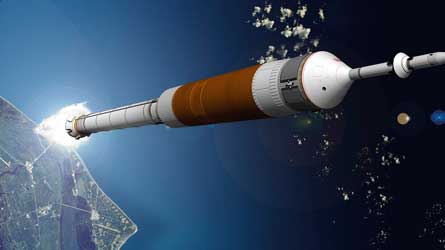Flights in 2009 will evaluate booster and abort system as Constellation managers finalise infrastructure strategy
NASA's Constellation programme managers have been given the go-ahead to carry out up to two test flights of the Ares I launcher, at a cost of $300 million.
The Ares I-1 test flight, and a repeat launch if the first fails, have been scheduled for April and October 2009, respectively.
Constellation programme manager Jeffery Hanley, exploration launch projects office director Steve Cook and Orion project manager Caris Hatfield last week revealed the first details of the test plans for the crew launch system. The Ares I-1 vehicle will have a four-segment first stage with an inert dummy fifth segment and mass simulators for the launcher's upper stage and Orion spacecraft payload (Flight International, 11-17 July). "We are going back to the Saturn I approach with a live first stage and a mass simulator," Cook says.
|
|
|---|
| Ares I could launch in 2009 |
He adds that the Ares I-1 first stage will use motors from the solid rocket boosters prepared for, but not flown on, the July 2005 Space Shuttle Discovery mission STS 114 and that the Ares I-1 will be transported to the pad using one of the Shuttle crawler-transporters. Hatfield says more details of the Ares launch infrastructure strategy will be released in about a month.
Other 2009 tests would include a five-segment motor ground firing, which NASA expects will prove it has 15% more thrust than needed. Hatfield, Cook and Hanley also insist they can achieve the safety target of an Ares/Orion launch failure rate of one per 2,000 flights, compared with the Shuttle's target of one in 200. An on-pad launch abort test will take place early in 2009, and in November or December of 2008 abort system testing will take place at the US Army's White Sands Missile Range in New Mexico.
Cook admits that the reaction time of the Ares I launch abort system (LAS) to a first-stage malfunction has yet to be determined. In the meantime a mock-up of the LAS has been built, as have an Orion service and crew module.
Testing carried out so far includes an Orion model being fired out of a cannon to test its aerodynamics and simulated crew module water and land landings using computers. A full Ares I atmospheric systems demonstration flight test (ADFT) is not expected to take place until mid-2012, because only then would the upper stage and its J-2 engine be "largely finished", says Hatfield.
The ADFTs will be followed by three orbital demonstration flight tests, with the third planned to be a manned flight to take place in September 2014.
Source: Flight International
























